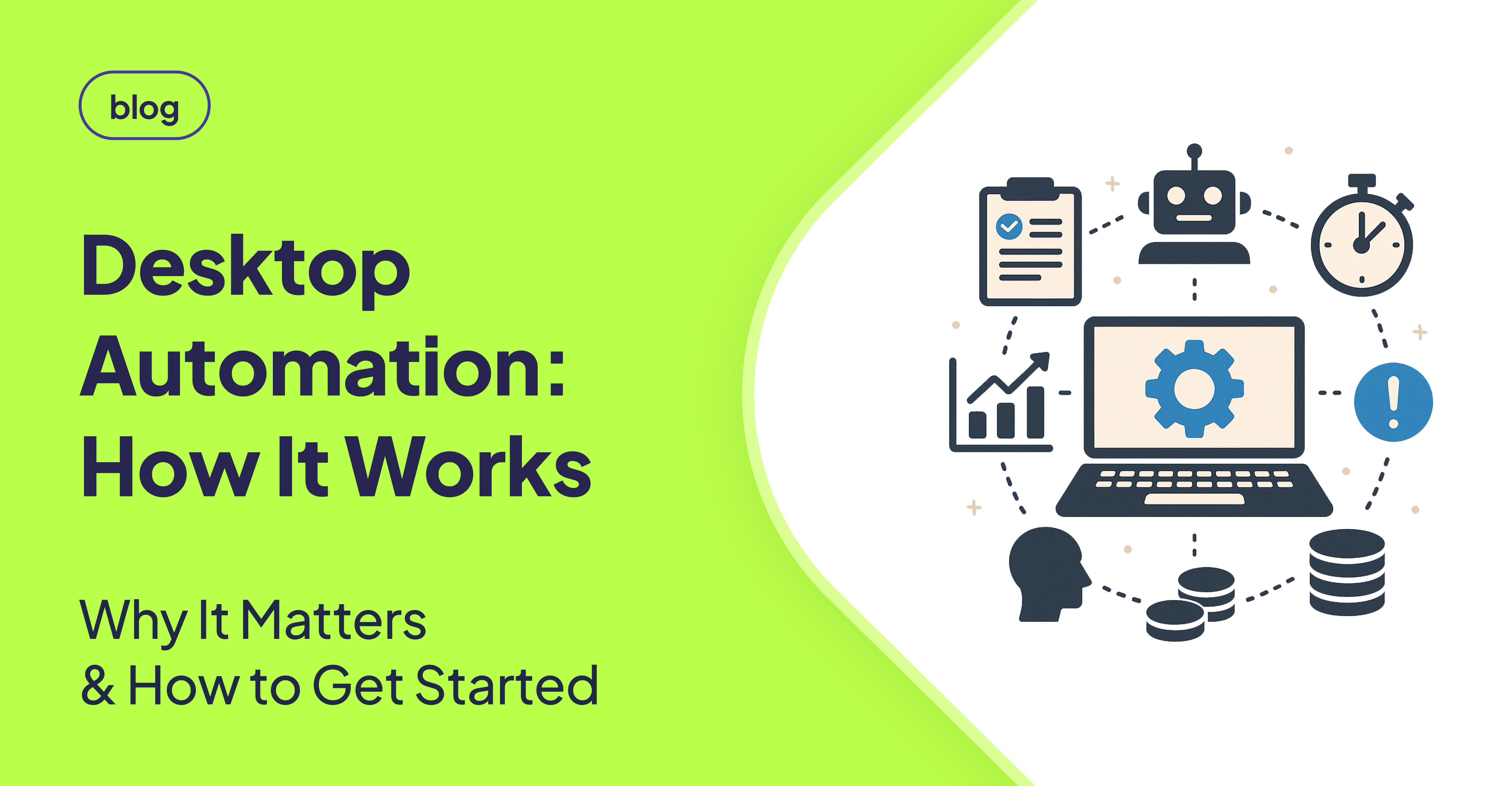TLDR
Desktop automation enhances productivity, minimizes errors, and liberates employees for more strategic work by automating repetitive computer tasks using software tools that mimic user actions. Successful implementation involves selecting the right tools, planning workflows, conducting thorough testing, and providing ongoing maintenance to maximize the return on investment.
Introduction
Desktop automation streamlines repetitive computer-based tasks, significantly boosting productivity and reducing human error. It leverages software tools that mimic user actions to automate workflows, spanning from simple data entry to complex report generation, ultimately freeing up employees to focus on higher-value activities.
The Power of Desktop Automation
Desktop automation involves automating rule-based tasks performed directly on a computer, often utilizing Robotic Process Automation (RPA) tools to replicate actions traditionally executed by humans. [STAT: The RPA market is projected to reach $13.77 billion by 2028, demonstrating the growing adoption of these technologies.] Common applications include data entry, file management, and report generation, with the primary benefit being the liberation of employees from monotonous tasks, allowing them to concentrate on strategic and value-driven activities. Unlike broader process automation initiatives, desktop automation is tailored to optimize local user environments, making it particularly well-suited for achieving rapid productivity gains.
The Strategic Importance for QA and Tech Teams
Desktop automation is crucial for QA managers, automation leaders, and engineering teams seeking to optimize both time and quality in their operations.
Boosting Productivity and Accuracy
Automating manual, repetitive tasks accelerates processes such as test preparation, data setup, and environment configuration. Furthermore, automation ensures consistent execution and enhanced data accuracy, significantly minimizing the risk of human error.
Driving Cost Efficiency and Compliance
By automating low-value work, organizations can reduce labor hours and reallocate resources to higher-impact projects. [STAT: Studies suggest that automation can reduce operational costs by up to 40%, illustrating the potential for significant savings.] Desktop automation also enforces adherence to data handling and process standards, which is essential for maintaining regulatory compliance. Effectively deploying desktop automation enables teams to manage higher workloads with fewer errors and faster turnaround times.
Selecting the Right Automation Tool
Choosing the appropriate desktop automation tool involves carefully aligning its features with your team's specific technical needs.
| Consideration | Why It Matters |
|---|---|
| Task Complexity | Tools range from simple macro recorders to advanced platforms supporting complex workflows with AI. |
| Integration Capabilities | The tool must seamlessly integrate with your current systems and CI/CD pipelines. |
| Ease of Use | GUI-based tools can significantly reduce onboarding time, particularly for QA and business users. |
| Scalability & Maintenance | Ensure the tool can scale with your organization's growth and is supported for long-term enhancements. |
Prioritize tools that incorporate OCR (Optical Character Recognition) or image recognition capabilities when automating UI-heavy testing or validation tasks.
Effective Implementation Strategies
To implement desktop automation effectively, follow these steps:
- Identify the Right Processes: Focus on automating high-frequency, rule-driven tasks that slow down QA or operational workflows. This includes generating test data sets, cross-checking files or logs, and triggering multi-step UI actions for regression tests.
- Plan Workflows Collaboratively: Map out each step of the automation process involving QA leads, developers, and operations personnel. Document inputs, triggers, decision points, expected outputs, and failure handling procedures.
- Test Before Full Rollout: Conduct pilot programs to validate both the functional accuracy (does it perform the job correctly?) and non-functional aspects (performance, security) of the automation.
- Train & Communicate: Hold concise training sessions to demystify automation and emphasize how it alleviates tedious work, rather than replacing employees.
Maintaining and Improving Automation
- Monitor: Continuously track execution logs, error rates, and processing times to identify areas for improvement.
- Report: Generate metrics to demonstrate the ROI of automation, such as hours saved or errors reduced.
- Update: Regularly install tool patches to address security vulnerabilities and maintain compatibility.
- Iterate: Gather user feedback to refine existing workflows and expand automation coverage.
Overcoming Common Challenges
| Challenge | Solution |
|---|---|
| Complex interfaces | Utilize OCR or visual recognition technologies to handle dynamic UIs effectively. |
| Software updates breaking scripts | Conduct thorough testing after updates and maintain modular scripts that are easily adaptable. |
| Security & privacy concerns | Implement stringent access controls, encrypt sensitive data, and conduct regular audits to ensure data protection and compliance. |
| Employee pushback | Demonstrate how automation reduces tedious work, provide comprehensive training, and involve employees in the automation process. |
Conclusion
Desktop automation provides significant advantages, including increased productivity, reduced errors, and cost savings, by automating repetitive computer-based tasks. Successful implementation requires careful tool selection, collaborative workflow planning, thorough testing, and ongoing maintenance. By addressing common challenges and providing adequate training, organizations can ensure successful adoption and maximize their return on investment.
FAQ
How does desktop automation differ from test automation?
Desktop automation focuses on automating any repetitive task performed locally, while test automation is specifically designed to validate software functionality and ensure its quality.
Can small teams afford desktop automation tools?
Yes, many tools offer tiered pricing models or open-source options that are suitable for startups and smaller teams, making automation accessible regardless of budget constraints.
What happens if the user interface (UI) changes?
Advanced tools utilize OCR and context recognition to adapt to UI changes, reducing the impact of updates on automation scripts. However, regular maintenance remains essential to ensure continued functionality.
How can we address employee concerns about job security with automation?
Transparency and communication are crucial. Emphasize that automation is intended to reduce tedious tasks, freeing employees to focus on more strategic and engaging work, rather than replacing them. Involve employees in the automation process to foster understanding and reduce anxiety.
What metrics should we track to measure the success of desktop automation?
Key metrics include hours saved, error reduction, cost savings, and improved turnaround times. Monitoring these metrics provides tangible evidence of the ROI of automation and helps identify areas for further optimization.
